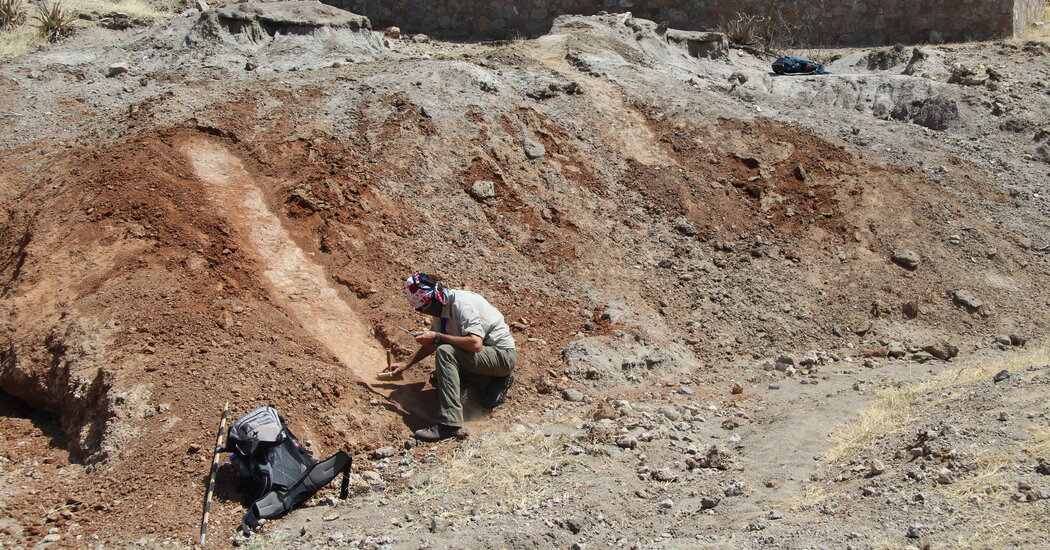
Chimpanzees reside best in African rainforests and jungles. Orangutans reside best within the forests of Indonesia. However people reside nice-looking a lot in every single place. Our species has unfold throughout frozen tundras, settled on mountaintops and known as alternative latter environments house.
Scientists have traditionally not hidden this flexibility as one of the most hallmarks of contemporary people and an indication of the way a lot our brains had developed. However a untouched learn about hints that perhaps we aren’t so particular.
1,000,000 years in the past, researchers have discovered, an extinct species of human kinfolk referred to as Homo erectus thrived in a harsh barren region park as soon as thought to be off limits ahead of Homo sapiens got here alongside.
“It’s a significant shift in the narrative of adaptability, expanding it beyond Homo sapiens to include their earlier relatives,” stated Julio Mercader, an archaeologist on the College of Calgary and an creator of the learn about, which used to be printed Thursday within the magazine Communications Earth and Order.
Fossils of our early forerunners accumulated over many many years looked as if it would verify the particular adaptability of our species. Our ancestors, referred to as hominins, fracture off from alternative apes in Africa about six million years in the past and lived for thousands and thousands of years in unhidden jungles. They didn’t appear to reside in latter environments.
Dr. Mercader and his colleagues intently tested environments in East Africa, which has yielded one of the crucial richest troves of hominin fossils. They picked a web page in northern Tanzania known as Engaji Nanyor the place paleoanthropologists had prior to now discovered fossils of Homo erectus.
Homo erectus is assumed to have developed about 2 million years in the past in Africa. They had been the primary to achieve the stature of contemporary people, and so they had lengthy narrow legs to run on. Their brains had been additionally better than the ones of previous hominins, even though best about two-thirds the dimensions of our personal.
Some time, Homo erectus expanded out of Africa, getting so far as Indonesia, the place they was extinct about 100,000 years in the past. In Africa, many researchers suspect, they gave get up to our personal species within the age a number of hundred thousand years ahead of disappearing there as smartly.
Dr. Durkin and his colleagues got down to resolve precisely what sort of climate Homo erectus lived in 1,000,000 years in the past at Engaji Nanyor. They checked out fossil pollen grains, analyzed the chemistry of the rocks and looked for alternative clues to the park.
“These studies are an immense amount of work,” stated Elke Zeller, a condition scientist on the College of Arizona who used to be no longer concerned within the mission.
For masses of 1000’s of years, the researchers aspiring, Engaji Nanyor were a at ease unhidden forest. However round 1,000,000 years in the past, the condition brittle up and the bushes vanished. The park grew to become to a Mojave-like barren region shrub land — a particularly arid park that gave the impression inhospitable for early hominins.
“The data led us to a pivotal question: How did Homo erectus manage to survive and even thrive under such challenging conditions?” Dr. Mercader stated.
Rather of absconding, the hominins found out how continue to exist of their converting house. “Their greatest asset was their adaptability,” Dr. Mercader stated.
They modified the way in which they looked for animal carcasses to scavenge, for instance. The hominins discovered the ponds and streams that sprang into lifestyles next storms. They didn’t simply drink at those fleeting watering holes. They hunted the animals that still confirmed up there, butchering their carcasses via the 1000’s.
The hominins additionally tailored via upgrading their equipment. They took extra serve when chipping flakes from stones to offer them a sharper edge. In lieu than simply select up rocks anyplace they had been, they most popular subject matter from specific playgrounds. And after they made a device, they carried it with them.
“They may have had strategies where they basically say, ‘This is a good tool. I should bring it with me and be ready if we find food,’” stated Paul Durkin, a geologist on the College of Manitoba who additionally labored at the learn about.
Dr. Durkin and his colleagues discovered that Engaji Nanyor used to be on the southern fringe of a immense belt of barren region shrub lands that stretched out of Africa, throughout a lot of the Heart East and into Asia. It’s imaginable that the adaptability that Homo erectus displayed at Engaji Nanyor helped them amplify to alternative continents.
Dr. Zeller and her colleagues have taken a special method to finding out hominins: developing large-scale condition fashions to determine what statuses had been like all the way through our evolution. Their fashions, just like the untouched learn about, counsel that Homo erectus will have thrived in environments that had been as soon as idea too harsh for species alternative than our personal.
Research like those Dr. Zeller and the Engaji Nanyor crew are carrying out “are all starting to tell the same story,” she stated. “We definitely have to look further back in time to understand our adaptability.”














